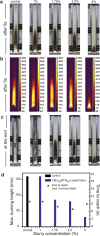Large-scale, thick, self-assembled, nacre-mimetic brick-walls as fire barrier coatings on textiles
- PMID: 28054589
- PMCID: PMC5215295
- DOI: 10.1038/srep39910
Large-scale, thick, self-assembled, nacre-mimetic brick-walls as fire barrier coatings on textiles
Abstract
Highly loaded polymer/clay nanocomposites with layered structures are emerging as robust fire retardant surface coatings. However, time-intensive sequential deposition processes, e.g. layer-by-layer strategies, hinders obtaining large coating thicknesses and complicates an implementation into existing technologies. Here, we demonstrate a single-step, water-borne approach to prepare thick, self-assembling, hybrid fire barrier coatings of sodium carboxymethyl cellulose (CMC)/montmorillonite (MTM) with well-defined, bioinspired brick-wall nanostructure, and showcase their application on textile. The coating thickness on the textile is tailored using different concentrations of CMC/MTM (1-5 wt%) in the coating bath. While lower concentrations impart conformal coatings of fibers, thicker continuous coatings are obtained on the textile surface from highest concentration. Comprehensive fire barrier and fire retardancy tests elucidate the increasing fire barrier and retardancy properties with increasing coating thickness. The materials are free of halogen and heavy metal atoms, and are sourced from sustainable and partly even renewable building blocks. We further introduce an amphiphobic surface modification on the coating to impart oil and water repellency, as well as self-cleaning features. Hence, our study presents a generic, environmentally friendly, scalable, and one-pot coating approach that can be introduced into existing technologies to prepare bioinspired, thick, fire barrier nanocomposite coatings on diverse surfaces.
Figures








Similar articles
-
Facile access to large-scale, self-assembled, nacre-inspired, high-performance materials with tunable nanoscale periodicities.ACS Appl Mater Interfaces. 2013 May;5(9):3738-47. doi: 10.1021/am400350q. Epub 2013 Apr 22. ACS Appl Mater Interfaces. 2013. PMID: 23534374
-
Halogen-Free Waterborne Polymeric Hybrid Coatings for Improved Fire Retardancy of Textiles.Polymers (Basel). 2023 Nov 23;15(23):4496. doi: 10.3390/polym15234496. Polymers (Basel). 2023. PMID: 38231923 Free PMC article.
-
A self-healing, recyclable, and degradable fire-retardant gelatin-based biogel coating for green buildings.Soft Matter. 2021 May 26;17(20):5231-5239. doi: 10.1039/d1sm00435b. Soft Matter. 2021. PMID: 33949608
-
Comprehensive Review of Recent Research Advances on Flame-Retardant Coatings for Building Materials: Chemical Ingredients, Micromorphology, and Processing Techniques.Molecules. 2023 Feb 15;28(4):1842. doi: 10.3390/molecules28041842. Molecules. 2023. PMID: 36838828 Free PMC article. Review.
-
Eco-Friendly Polymer Nanocomposite Coatings for Next-Generation Fire Retardants for Building Materials.Polymers (Basel). 2024 Jul 17;16(14):2045. doi: 10.3390/polym16142045. Polymers (Basel). 2024. PMID: 39065362 Free PMC article. Review.
Cited by
-
Migration of Quaternary Ammonium Cations from Exfoliated Clay/Low-Density Polyethylene Nanocomposites into Food Simulants.ACS Omega. 2019 Aug 7;4(8):13349-13359. doi: 10.1021/acsomega.9b01529. eCollection 2019 Aug 20. ACS Omega. 2019. PMID: 31460463 Free PMC article.
-
Mild and Versatile Functionalization of Nacre-Mimetic Cellulose Nanofibrils/Clay Nanocomposites by Organocatalytic Surface Engineering.ACS Omega. 2020 Jun 29;5(31):19363-19370. doi: 10.1021/acsomega.0c00978. eCollection 2020 Aug 11. ACS Omega. 2020. PMID: 32803029 Free PMC article.
-
Barrier Effects of Cellulosic Fibers with Hybrid Coating Based on Zirconium Metal-Organic Framework.Polymers (Basel). 2022 Jul 29;14(15):3071. doi: 10.3390/polym14153071. Polymers (Basel). 2022. PMID: 35956585 Free PMC article.
-
Investigation on the Preparation and Properties of CMC/magadiite Nacre-Like Nanocomposite Films.Polymers (Basel). 2019 Aug 22;11(9):1378. doi: 10.3390/polym11091378. Polymers (Basel). 2019. PMID: 31443463 Free PMC article.
-
Fabrication of Water-Resistant Nacre-like Polymer/Clay Nanocomposites via in Situ Polymerization.ACS Omega. 2017 Nov 30;2(11):8475-8482. doi: 10.1021/acsomega.7b01606. eCollection 2017 Nov 30. ACS Omega. 2017. PMID: 31457384 Free PMC article.
References
-
- Wakelyn P. J., Bertoniere N. R., French A. D. & Thibodeaux D. Cotton Fiber Chemistry and Technology.CRC Press & (Taylor and Francis Group): Boca-Raton, F., p 77–80 (2007).
-
- Liodakis S., Fetsis I. K. & Agiovlasitis P. J. The fire-retarding effect of inorganic phosphorus compounds on the combustion of cellulosic materials. Therm. Anal. Calorim. 98, 289−291 (2009).
-
- Wu X. & Yang C. Q. Flame Retardant Finishing of Cotton Fleece Fabric: Part III — The Combination of Maleic Acid and Sodium Hypophosphite. J. Fire Sci. 26, 351−368 (2008).
-
- Cusack P. A. In Plastics Additives, Polymer Science and Technology Series Vol. 1 Polymer Science and Technology Series Ch. 37, 339-352 (1998).
-
- Friederich B. et al.. In Integrated Systems, Design and Technology 2010 (eds Fathi Madjid, Holland Alexander, Ansari Fazel & Weber Christian) Ch. 5, 47–58 (Springer: Berlin Heidelberg,) (2011).
Publication types
LinkOut - more resources
Full Text Sources
Other Literature Sources

